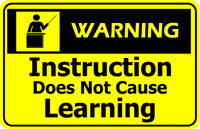Jon Revelos (Director – Story Based Learning at TATA
Interactive Systems) has a great post where he posits that storytelling is the most effective means of passing knowledge from an expert to a beginner.
Using the example of “corporate earnings were 3.2 billion dollars as a data point” he shows that, depending on the story, that might be good news or bad. It might indicate an upward path, a downward path, or just general confusion.
Imagine the final step in this example chain – instead of
being given a bulleted fact, or even a graphical chart, you are provided a
compelling narrative of the events that influenced a company’s fiscal
performance Maybe a story of how a small oil and gas company played a role in
one of the largest bankruptcies in
well-understood are terms like “securities fraud” in the post
Enron/Worldcom era? Why? Because stories
were told – stories of greed, arrogance, fraud, trust, loss, and ruin – that
brought obscure accounting terms and practices out of the textbooks and into
the personally relevant world of everyday people.
I’ve always tried to follow Joseph Campbell’s “The Myth of the Hero” model, where he describes the universal pattern of storytelling.
In this study of the myth of the hero, Campbell posits the
existence of a Monomyth (a word he borrowed from James Joyce),
a universal pattern that is the essence of, and common to, heroic tales
in every culture. While outlining the basic stages of this mythic cycle,
he also explores common variations in the hero’s journey, which,
he argues, is an operative metaphor, not only for an individual, but
for a culture as well. The Hero would prove to have a major
influence on generations of creative artists—from the Abstract
Expressionists in the 1950s to contemporary film-makers today—and
would, in time, come to be acclaimed as a classic.
One of my favorite applications of this model is “Beyond Bullet Points” as described by Cliff Atkinson. He gives you a great model of how to take a typical boring PPT presentation and re-work it into something that is moving, effective and anything but boring. Each year at TechEd I would see speakers grow and improve using just this model.
“This fellow can make PowerPoint do things that I never knew could be
done at all. What he says is not difficult to do, it’s just a different
way of thinking about how to make a presentation.”
– John Matlock Amazon.com Top 500 Reviewer
Powered by ScribeFire.

{ 2 comments… read them below or add one }
Re: John Revelos & Story Based Learning – It certainly is more interesting sometimes to hear a story than work on the skill sets necessary to get the work done (and that’s a learning desinging motivatinal problem) but I hope, for example, we don’t rely soley on “story time” (or tomes) to effect “zero tolereance for errors” (ZTF) in the nuclear industry, construction of the instrumentation of the Boeing 787 or the Mariners staying above 500 – my point – stories are fun (if told well) but stories hav a low probability of producing correct response increase/error reduction for more than 15% of the population involved in process and that’s probably streching it. Real stories/examples are important to effective learning design but “transfer of learning & generalization of learning” have been demonstrated over & over to not be effectively impacted thorugh stories…
Re: Richard’s thoughts on the effectiveness of Story in transfer and generalization of learning.
I’m appreciate your weighing in on this topic, but I fear you may have overly marginalized the potential power of story (i.e. “story time” and “fun”). I’d also be interested in learning more about the evidence upon which you base your closing comment (“…demonstrated over and over to not be effectively impacted through stories”), as it doesn’t reflect the research I’ve seen.
It’s certainly important to draw a line of distinction regarding any inference made about stories being “solely” used or the topics targeted. I see Story as a powerful (if underutilized) tool in the Instructional Designer’s toolbox, but still only one of many that are available. I draw the analogy of using a wrench to drive a nail – sure you CAN do it, but there’s a better tool out there; better in terms of the effort that must be extended, the time it takes to complete the task, and the quality of the final product. So, we must be careful in the selection and use of ANY instructional strategy, so as to use the best approach for the problem at hand.
In that vein, stories probably aren’t the best tool to teach lower-level cognitive objectives or highly technical procedures (explict knowledge). Rather, they are better suited towards soft skills, change management, and the implicit (tacit) knowledge retention/transfer issue that accompanies the notorious “Great Brain Drain” that is getting so much press of late related to the Baby Boom Generation’s looming retirement tidal wave. Stories work well where traditional fact- and logic-driven “just tell ‘em” instructional strategies fall short. But even in those domains, I would never advocate that they be used “solely” any more than I’d suggest that building wooden-framed buildings should be done soley with a hammer.
Finally, with regards to your closing claim, I’d encourage you to look into some of the works of Stephen Denning, Dave Snowden, Thomas Davenport, Lori Silverman, and Roger Schank (who goes so far as to suggest that all understanding and learning is fundamentally grounded in story, and that our DNA/brains are hardwired to resonate with stories as a sense-making and retention/recall mechanism). I would suggest almost the polar opposite of what you claim – that stories are extremely effective in the comprehension (both transfer and generalization), retention, and application of several domains of information. Thus, your comment (along with the “low probability” and “15% that precede it) creates a mental ‘itch’ for me that I’m hoping you can help ‘scratch’ with some links and/or references.